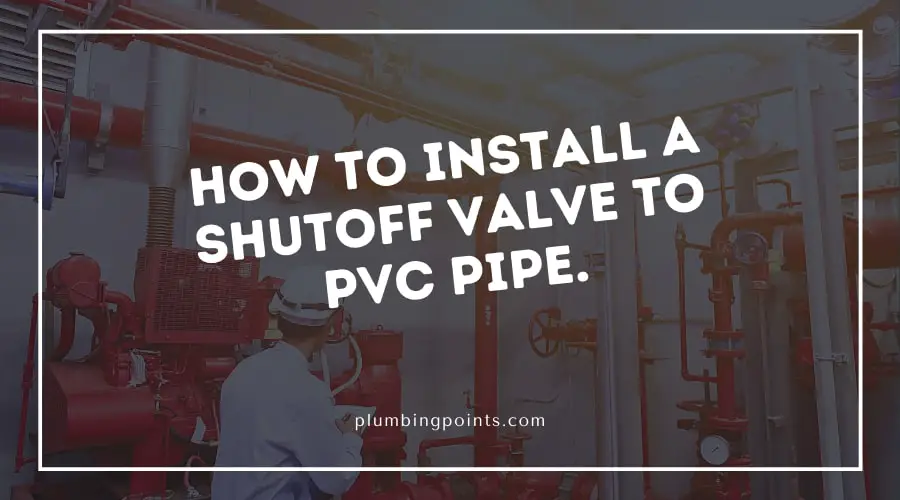Last Updated on August 27, 2022 by admin
Plastic piping is a comparatively convenient option as it is easy to modify. You do not require to be a plumber to connect a shutoff valve to a PVC pipe. Read this article to know the methods of connecting a shutoff valve to plastic pipe.

Table Of Contents
Methods of connecting a shutoff valve to plastic pipe
Step 1
At first, dry and clean the inside and outside of your PVC pipe with a cloth. Ensure that the plastic pipe’s end is utterly dry before moving to the next step.
Step 2
Make the use of PVC cement to the end PVC pipe so that it complements each other. You will receive a dabber along with PVC cement at the time of purchasing this product. Use this dabber to put a sufficient amount of PVC cement to the end of the PVC pipe.
Step 3
Attach the PVC pipe with PVC adaptor by connecting the end of the PVC adapter with the end of the PVC pipe. Then, you need to pass the PVC pipe into the adapter and rotate the PVC pipe in order to mesh the PVC cement so that the PVC pipe and adapter fit together.
Step 4
Find a Teflon Tape and use that one on the other hand of the PVC adapter. Use your finger to smooth the Teflon Tape after applying it to the threaded inside of the PVC adapter.
Step 5
Now install the shutoff valve by connecting the shutoff valve into the threaded end of the PVC adapter by using a screw. Place the shutoff valve along with threads in order to evade damage to the PVC adapter.
Step 6
Tight the valve into the PVC adapter with a crescent wrench. Do not tighten it too much otherwise, it would cause damage to the thread.
How to Replace Shut Off PVC Valve
What is PVC pipe?
Polyvinyl chloride, abbreviated as PVC, is one the most used synthetic plastic polymer. Every year people around the world produced nearly 40 million tons of PVC.
There are mainly three types of PVC pipe. They are;
- UPVC: it is the abbreviated form of unplasticized PVC. Manufacturers do not add any plasticizer to the PVC compound for this type of pipe. People use this one for their plumbing system as it is comparatively more rigid.
- C-PVC: it stands for chlorinated PVC. Drinking water is safer from this type of pipe. This type of pipe does not deteriorate means you can use this one for a longer period of time. It can work in a broad range of temperatures. It is most popular in residential and commercial areas for piping. The great thing about this kind of pipe is we can recycle it utterly.
- PVC-O: it stands for molecularly oriented. The manufacturer of this type of pipe converts the amorphous structure of UPVC into a layered structure in order to make them resistant to corrosion. People can drink water as it is safe and it provides good results compared to the cost.
What is CPVC?
CPVC and PVC have a great deal of similarity. However, it is not a good idea to use it interchangeably though this two are consist of some basic components with one distinguishing feature. The effectiveness of the chlorine content increases because CPVC is altered by a free radical chlorination reaction. As CPVC is thermoplastic, it is shaped into a similar product like PVC.
CPVC can function its task in wide range of temperatures. Because of this, a number of building codes need CPVC piping compare to PVC pipes when it comes to hot water applications.
Difference between CPVC and PVC pipe
Mainly these two differ in the range of temperatures that they are capable of defending. CPVC is able to function its works in temperatures up to 200 Fahrenheit. On the other hand, PVC can work in up to 140 Fahrenheit. If it is more than the above mention temperatures, both these types of pipe will start to become soft, and thereby the chances of failure of joints and pipes will increase.
The use of solvent cement, primers is not similar for CPVC and PVC because of the unidentical composition of chemicals. For instance, the standard specification for CPVC is ASTM F493 whereas the standard specification for PVC is ASTM D2564.
CPVC is plastic which people use for water lines. While PVC is also plastic pipe that people use for drain/waste/ vent lines.
Some people may want to know the answer to the following questions.
What is PVC spigot fitting?
Spigot refers to a fitting where the end of a fitting connected to another one in a way that fits together. The outside diameter of the pipe is almost the same as the outside fitting of spigot. You can attach the spigot end of a fitting into a Hub or Socket and the Socket or Hub is regarded as the female connection of PVC fittings.
How can I connect a spigot to a PVC pipe?
Use a plumbing tape to wrap the threads of Male Pipe brass or copper faucet and with a view to connecting the faucet to PVC pipe make the use of screw on a PVC female adapter. Use pump pliers to tight the connection at the time of turning the adapter with a wrench. Use the PVC cement to attach the adapter to PVC pipe
